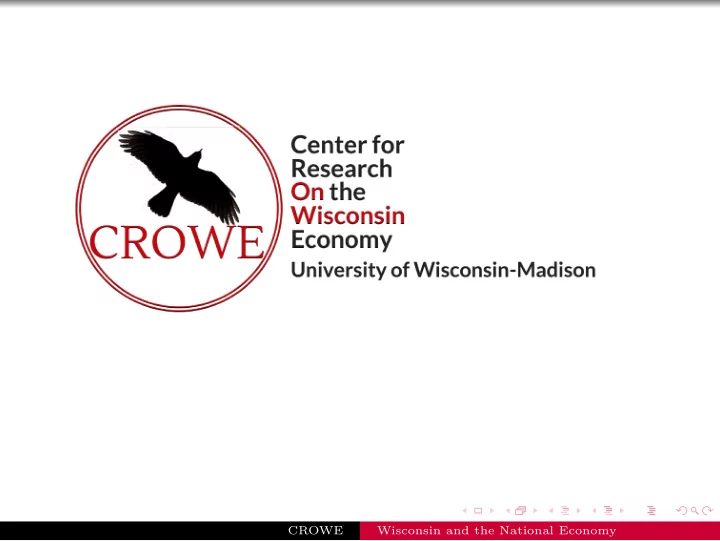

CROWE Wisconsin and the National Economy
CROWE and the Wisconsin Economy Noah Williams University of Wisconsin-Madison Center for Research On the Wisconsin Economy (CROWE) https://crowe.wisc.edu CROWE Wisconsin and the National Economy
CROWE: Brief Introduction Center for Research on the Wisconsin Economy (CROWE) recently established in the Department of Economics. Mission: to support and disseminate economic policy research, with a particular focus on the Wisconsin economy and state-level economic policy issues Goals: Understand forces driving economic outcomes and the impacts of policies at the state-level Make economic research accessible to policymakers, businesses, and community in Wisconsin and beyond Provide opportunity for UW students to engage in research & policy process Recently added staff, but looking to grow. CROWE Wisconsin and the National Economy
Outlook for the Wisconsin Economy Tight labor market: low unemployment, high employment-population ratio Labor force challenges: low population growth, aging workforce, low migration State economy has diversified but remains manufacturing -heavy. Long-term decline in manufacturing employment, but growth since 2010. Major fiscal policy changes in recent years, potential for tax reform Forecast : slow and steady growth over next two + years CROWE Wisconsin and the National Economy
Unemployment and Employment-Population Unemployment Rate Employment−Population Ratio 68 US 10 WI 67 9 66 65 8 64 7 63 6 62 61 5 60 4 59 3 58 2006 2008 2010 2012 2014 2016 2018 2006 2008 2010 2012 2014 2016 2018 CROWE Wisconsin and the National Economy
Employment and Labor Force Nonfarm Employment, 2010=100 Labor Force, 2010=100 105 US 114 WI 104 112 103 110 102 108 101 106 100 104 99 102 98 100 97 98 96 2006 2008 2010 2012 2014 2016 2018 2006 2008 2010 2012 2014 2016 2018 CROWE Wisconsin and the National Economy
Labor Mobility and Wisconsin Project by James Walker, CROWE Faculty Fellow Low labor force growth driven by aging of population, low migration Between 1990–2016 annual interstate migration rate in US fell by half (about 3.0% to 1.5%). Wisconsin migration rates were in the middle to bottom half in 1986 and continue to be so in 2016. Wisconsin has experienced a net outflow college graduates in recent years (2010–2017) but the loss is (in relative and absolute terms) smaller than in early 1990s. CROWE Wisconsin and the National Economy
Decline in Labor Mobility Migration rates by single–individuals fell by more than married individuals: demographics not likely the cause. Migration rates declined by half for all distance moves. Suggests changes in housing market potentially as important as labor market. Timing of migration decline varies by educational group. Currently investigating causes, exploring migration behavior of graduates of two- and four-year colleges. Table: Annual Interstate Migration Rates: Males Ages 25–55 (%) Group 1986 1996 2006 2016 All 3.4 2.8 2.0 1.7 College grad 5.1 3.9 2.5 2.3 HS grad 2.6 2.7 1.6 1.3 < HS 2.3 2.4 1.7 1.3 CROWE Wisconsin and the National Economy
Competition and Productivity Growth in the Rust Belt Alder, Lagakos, Ohanian Output share of manufacturing in Wisconsin: 36% in 1963 18% in 2016 Discussion on decline of manufacturing focuses on: 1 structural change 2 international trade 3 skilled-biased technological change Paper argues that decline of manufacturing in Rust Belt largely homemade: 1 adversarial labor-management relations 2 lack of competition in output markets CROWE Wisconsin and the National Economy
The Rust Belt: Four Key Facts 1. Secular Employment Decline CROWE Wisconsin and the National Economy
The Rust Belt: Four Key Facts 2. High Wages (a) Rust Belt (b) Wisconsin CROWE Wisconsin and the National Economy
The Rust Belt: Four Key Facts 3. Low Productivity Growth Annualized Growth Rate, % 1958-1985 1985-1997 1958-1997 Blast furnaces, steelworks, mills 0 . 9 7 . 6 2 . 8 Iron and steel foundries 1 . 5 2 . 3 1 . 7 Metal forgings and stampings 1 . 5 2 . 8 1 . 9 Metalworking machinery 0 . 9 3 . 5 1 . 6 Motor vehicles and motor vehicle equipment 2 . 5 3 . 8 2 . 9 . . . . . . . . . Rust Belt weighted average 2 . 0 4 . 2 2 . 6 Manufacturing weighted average 2 . 6 3 . 2 2 . 8 CROWE Wisconsin and the National Economy
The Rust Belt: Four Key Facts 4. Adversarial Labor Relations Pre-1980s CROWE Wisconsin and the National Economy
Implications Reduction in labor market conflict and increased competition from international trade helped stem the relative decline of manufacturing in the Rust Belt and in Wisconsin. High wages and relative stability in 1950s were not sustainable. Today’s manufacturing jobs require more skilled labor and more capital (capital-skill complementarities). From post-recession low in 2010, Wisconsin has added 50,000 manufacturing jobs (+12%). CROWE Wisconsin and the National Economy
Economic Forecasts Ongoing project at CROWE on modeling state economies. Engaging student research assistance: undergraduate, Masters, and PhD. We adapt an approach used the Federal Reserve Bank of Minneapolis to forecast the US economy. We modify to national and state levels. Assumes current federal and state policies continue. Extend for quantitative policy evaluation like tax reform. Currently extending to all 50 states. No comparable publicly available state-level forecasts. CROWE Wisconsin and the National Economy
Wisconsin Forecast: Unemployment Rate CROWE Wisconsin and the National Economy
Wisconsin Forecast: Employment CROWE Wisconsin and the National Economy
Wisconsin Forecast: GDP CROWE Wisconsin and the National Economy
National Forecast: GDP CROWE Wisconsin and the National Economy
Forthcoming CROWE Research Current Projects Alder, “Competition and Productivity Growth in the Rust Belt.” Released today at crowe.wisc.edu Guo and Williams, “An Outlook for the Wisconsin Economy” Walker, “Labor Mobility and Wisconsin” Future Projects Growth and Business Cycles in US States Evaluating Fundamental State Tax Reform Economic Opportunity and Economic Freedom CROWE Wisconsin and the National Economy
Recommend
More recommend